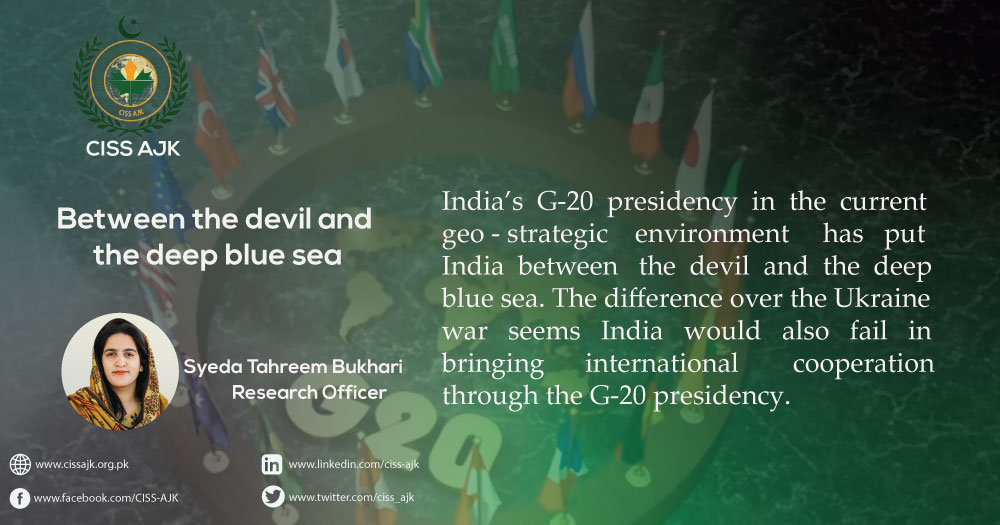723
INDIA is holding the G-20 Presidency of top twenty diplomats of the world’s top biggest economies from December, 2022 to November, 2023. India is hosting the global diplomacy, the current geopolitical scenario seems to be a grand test of India’s diplomacy. With ongoing war between Russia and Ukraine whether India will be able to bring consensus between the allies and the arch rivals. India’s G-20 presidency in the current geo-strategic environment has put India between the devil and the deep blue sea. Till now, India has arranged two meetings under the G-20 presidency. The first meeting was in Bangalore of Finance Ministers of G-20 countries which ended with no consensus. The fate of the second meeting of Foreign Ministers in New Delhi was also the same, India failed to develop consensus among the G-20 countries as no joint statement was issued.
The Indian President highlighted the failure of the global governance system in preventing global wars and international cooperation. The difference over the Ukraine war seems India would also fail in bringing international cooperation through the G-20 presidency. India’s G-20 agenda highlights the urgent need to deal with climate change, the increasing burden of debt, digital transformation, rising inflation, and food and energy security. These issues impact every government and their citizens. The G-20 summit could have done to build consensus on these issues but war in Ukraine has come in the way. The G-20 failed to look beyond the conflict. It is also evident from the fact that there is no family photo of the G-20 meeting.
A family photo is when all the leaders attending the meeting come together for a click but the leaders of G-7 the US, UK, Canada, France, Germany, Italy and Japan were not on board. India diplomatically failed to bring them in sharing frame with Russians. This was the second time, there was no photo session in the Bali meet last year either. The failure of Indian diplomacy is also evident as most of the participants did not attend the inaugural dinner. In the G-20 meet, the US and Russia were in the same room for the first time in almost a year. India failed to keep the discussion focused on the agenda of G-20 meet to address the challenges of growth, developing economic and disaster resilience, finance stability, transnational crimes, corruption, terrorism and food and energy security. The war of words started between the US and his Russian counterpart.
The United States Secretary of State Antony Blinken tried to rally more support for Ukraine, while Russian Minister for Foreign Affairs Sergey Lavrov tried to mount a counter attack. It had been their first face to face interaction since the Ukraine war began. The Blinken highlighted that the US will continue to support Russia, and demanded from Russia to rejoin the New Start Treaty. He also demanded the release of Paul Whelan, an American citizen sentenced to 16 years jail in Russia on account of spying. Lavrov claimed that the western diplomats are derailing the meeting in an effort to scapegoat Russia and apologize to India for the meeting agenda turning into a farce.
The Indian diplomats failed to keep the G-20 meet focused on the agenda. In future it might put India in a difficult situation if the West demanded from India to take a clear stance on the Ukraine war. As recently India abstained from voting in a UN General Assembly that condemned Russia’s invasion of Ukraine. India reiterated its position on the invasion, saying that peaceful dialogue was the only way out. The G-20 meet was a platform for peaceful dialogue and international economic cooperation where India failed to bring consensus between the two. The war in Ukraine cast shadows on India’s G-20 Presidency and other major issues including climate change, rising inflation, and food and energy security.
—The writer is a Research Officer at the Centre for International Strategic Studies, AJK.



